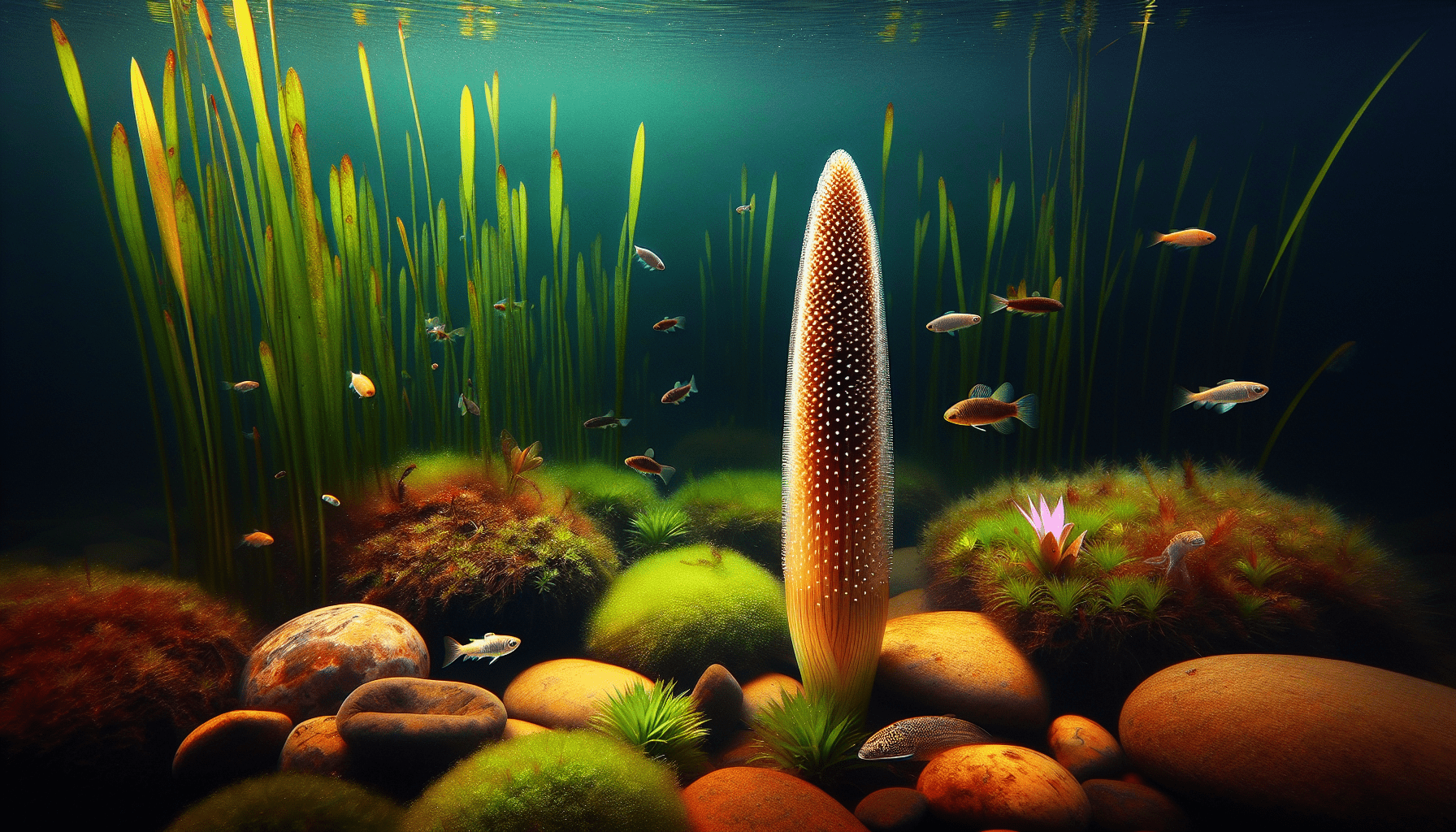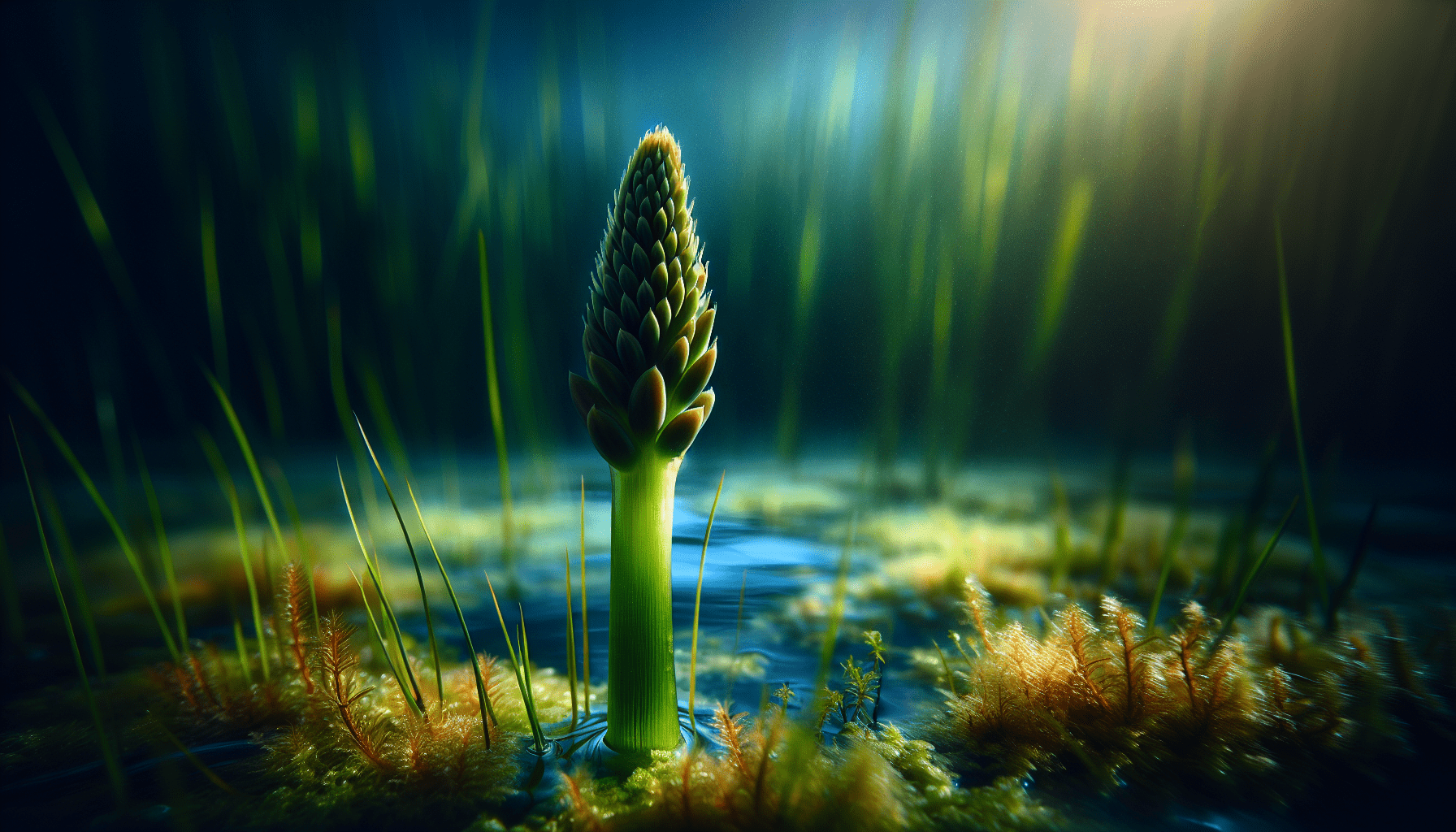As you embark on a scholarly exploration into the world of aquatic floras, the Aquatic Weed Eleocharis presents itself as an interesting subject. Its uniqueness lies within the array of remarkable traits it possesses, extending from its one-of-a-kind environmental tolerance to the role it plays in the ecosystem. This distinctive reed-like aquatic plant hails from the Cyperaceae family and is recognized for its achievements in elements of terrestrial and aquatic adaptability. This article offers a comprehensive understanding of the importance of Eleocharis, its features, its global distribution, and its various uses and impacts—both beneficial and detrimental—within its inhabited environments. Armed with this knowledge, you’ll possess a more profound grasp of the subtle intricacies that shape the aquatic realm.

Overview of Eleocharis
Description of the plant
Eleocharis, commonly referred to as spike-rush, is a genus of about 250 species of flowering plants in the sedge family, Cyperaceae. These plants are notable for their simple, grass-like appearance, though they are generally not tall, typically measuring from 10cm to 1m in height. They usually possess cylindrical, hollow stems, small flowers, and a tuft of bristles replacing the perianth. Their leaves are reduced to small sheaths around the base of the stem. Their distinguishing feature is their spikelet: a group of small flowers packed onto the stem, which gives the appearance of a spiked rush – hence their common name.
Common names and etymology
The name Eleocharis originates from the Greek words ‘helos’ meaning ‘marsh’ and ‘charis’ meaning ‘grace’, symbolizing the plant’s elegance and preference for wet environments. Another common name for the species found in this genus is spike-rush. This is attributed to the distinctive clusters of flowers or spikes present at the top of an elongated stem resembling rushes. Other regional names include needle spike-rush, dwarf spike-rush, tall spike-rush, and bald spike-rush, each reflecting identifiable attributes of different species within the Eleocharis genus.
Characteristics of Eleocharis
All Eleocharis species share specific structural and morphological characteristics, making them easily recognizable. They possess slender, erect, and cylindrical stems, bearing a single terminal spikelet, giving them their familiar rush-like appearance. The plants often have a shallow root system, ideal for the waterlogged environments they inhabit. The achenes or single-seeded fruits of Eleocharis are also characteristic, displaying diverse shapes and sizes, depending on the species. These achenes play a vital role in the plant’s propagation, ensuring the continued survival of these fascinating plants in their respective habitats.
Taxonomy of the Eleocharis Genus
Classification within the plant kingdom
The Eleocharis genus is a member of the Cyperaceae family, more commonly known as the Sedge family. This family is part of the larger order Poales, which includes significant families such as the grasses (Poaceae) and rushes (Juncaceae). The plant kingdom, also known as Plantae, comprises the complete hierarchical classification of Eleocharis, demonstrating its unique position in the realm of botany.
Important species and their distribution
Key Eleocharis species include E. palustris, E. acicularis, and E. uniglumis, among others. These species showcase the genus’s wide geographical distribution. E. palustris, or the common spike-rush, prominently thrives in Europe, Asia, and North America. E. acicularis, known as needle spike-rush, populates similar regions, with additional distribution in Australia. E. uniglumis or the slough spike-rush marks another species with an extensive range, extending from North America to Northern Asia.
Comparison between species
Despite the common characteristics within the Eleocharis genus, a closer examination reveals marked differences between species. For instance, E. palustris displays wide leaf sheaths and dark brown to black achenes, whereas E. acicularis possesses narrower leaf sheaths and light brown achenes. The height of the plants can also vary widely, with some like E. uniglumis reaching up to 1m, while E. acicularis usually remains under 30cm.
Ecology and Habitats
Common habitats of Eleocharis
Species of Eleocharis predominantly inhabit wet and saturated environments, including swamps, marshes, bogs, river banks, and the margins of ponds and lakes. This natural inclination towards aquatic biomes defines their universal distribution, proliferating anywhere with standing or slow-moving water. Certain species even thrive in salty coastal environments, highlighting their adaptability.
Environmental conditions required for growth
For optimal growth, Eleocharis require waterlogged or constantly moist soils with preferably neutral to mildly acidic pH. They can tolerate a wide range of sunlight exposure, from full sun to partial shade. While particular species are adapted to withstand the saline conditions of coastal marshes, most prefer freshwater habitats. Temperature tolerance varies by species, with some adapted for cooler northern climates and others tolerant to a more tropical environment.
Populations in freshwater ecosystems
The abundant water and nutrient availability of freshwater ecosystems render them ideal for the proliferation of Eleocharis. Aquatic species create extensive underwater meadows, particularly in shallow regions. These stands contribute significantly to the ecosystem, providing habitat for aquatic fauna and helping to preserve water quality by reducing nutrient loads.

Growth and life cycle
Stages from germination to mature plant
The Eleocharis life cycle starts with seed germination, usually occurring when temperatures warm in the spring. Following germination, the young plant or seedling grows rapidly, developing its characteristic stem and leaf sheath. By mid-summer, the plant reaches maturity, characterized by the emergence of its single terminal spikelet. The mature Eleocharis plants produce seeds in late summer or fall, ready to germinate and start the cycle anew the following spring.
Seasonal changes in development
The growth of Eleocharis is influenced significantly by seasonal changes. With the arrival of warmer spring temperatures, germination takes precedence. The quick growth and maturation occur in summer, leading to flowering and seed production toward summer’s end or early autumn. As temperatures plummet in fall and winter, plant growth slows, and they adopt a form of dormancy, surviving harsh conditions to grow again the next year.
Longevity of the plant
As predominantly perennials, Eleocharis species can live for several years, regrowing each spring from existing rootstock to provide a continuous presence in their habitats. The exact longevity of these plants can vary significantly depending on species, environmental conditions, and competitive pressures from other plant species.
Adaptations to Aquatic Environment
Special structures for underwater growth
To cope with waterlogged environments, Eleocharis species have developed several adaptions. Their hollow, air-filled stems allow for the necessary gas exchange under water, enabling the plant to ‘breathe’. The slender and flexible nature of their stems allows them to sway with water currents, reducing damage from the movement of water.
Survival strategies in waterlogged conditions
In addition to structural adaptations, Eleocharis possess survival strategies to endure in their preferred habitats. They typically produce extensive root systems, enabling them to anchor firmly within the water-soaked soil. several species have a high tolerance for anoxia or oxygen scarcity typical of saturated soils. Their wind-dispersed seeds also float on water, ensuring that they can populate riparian habitats effectively.
Role of the aquatic environment in reproduction
The aquatic habitats of Eleocharis support its reproduction by providing the necessary moisture for germination and growth. Additionally, water can aid in seed dispersal, carrying them away from the parent plant to colonize new areas. Specific species are even capable of vegetative reproduction through aquatic rhizomes, expanding their reach within an aquatic ecosystem.
Benefits of Eleocharis in Ecosystems
Contributes to biodiversity
Eleocharis, in densely forming stands, operate as crucial biological components of several wetland ecosystems. These structures provide essential habitats and refuge for a variety of organisms, thus enhancing local biodiversity. This includes nesting and feeding grounds for birds, and spawning grounds for fish and amphibians.
Role in nutrient cycling
Eleocharis score high in nutrient cycling, absorbing nutrients from the water and returning them to the ecosystem upon decay, contributing to their role as biofilters. In essence, they improve water quality by absorbing excess nutrients, reducing eutrophication risks—an ecological process characterized by an excessive amount of nutrients leading to dense plant growth and subsequent death due to oxygen deficiency.
Habitats and food source for wildlife
The flora of Eleocharis also serve as a valuable food source, with waterfowl and other bird species regularly consuming their seeds. Additionally, the dense meadows provide protective habitats for numerous aquatic invertebrates and small fish, reinforcing its role as a critical resource within a wildlife ecology.
Challenges Posed by Eleocharis
Negative impacts on other plant species
While Eleocharis contributes substantially to the ecosystems they inhabit, their vigorous growth can sometimes lead to challenges. Their dense mat can overshadow smaller plant species, potentially stifling their growth and leading to reduced plant diversity. They can also clog waterways, hindering organisms’ movement and possibly altering the ecosystem’s dynamics.
Role as an invasive species
Certain Eleocharis species have gained notoriety as invasive species outside their native ranges. Their efficient reproductive strategies, in combination with a propensity for dense cluster formation, can lead to rapid population expansion, often to the detriment of native plant species. They can thereby alter habitats and disrupt local biodiversity severely.
Difficulties in controlling large populations
Controlling and managing excessive Eleocharis populations can pose significant challenges. Their extensive growth, fast reproduction, and resilience to standard control measures can make eradication difficult. Physically removing these plants often proves ineffective due to their ability to regenerate from remaining roots. Chemical treatments may harm non-target species, complicating management efforts even more.
Uses of Eleocharis
Utility in ornamental aquascaping
In a controlled environment, Eleocharis can provide aesthetic value within the realm of ornamental aquascaping. Sometimes referred to as ‘aquarium grass,’ this plant genus is a popular choice for creating a ‘carpet effect’ within aquariums due to its short growth and bright green color, providing an appealing contrast to other aquarium elements.
Historical uses in traditional medicine
Certain Eleocharis species have a history of use within traditional medicine systems in various cultures worldwide. For instance, the tubers of some species are used in traditional Chinese medicine for their diuretic and hemostatic properties. Some Native American tribes have used them as food and medicine, eating the seeds and tubers, and using the plant in remedies for ailments such as respiratory or urinary tract infections.
Potential modern applications
Modern applications of Eleocharis are being investigated, focusing especially on their potential benefits in biological control of water pollutants due to their nutrient-absorbing properties. They can also serve as a sustainable, natural solution to coastal erosion issues, given their soil-binding capability provided by their extensive root systems.
Case Studies of Eleocharis Infestation
Impacts on local ecosystems
Instances of Eleocharis infestation have shown how they can significantly alter local ecosystems. For example, the introduced E. parvula has drastically changed the California salt marsh ecosystems, leading to biodiversity loss and shifts in food web dynamics due to its invasive nature.
Methods used for control and eradication
Various control methods have been utilized to combat Eleocharis infestations. These range from physical interventions like mowing or dredging to chemical treatments with specific herbicides. Biological controls, such as the use of specialized insects, are also being investigated as potential control strategies.
Long-term effects of infestations
Infestations of Eleocharis can have long-term effects on ecosystems. The altered habitats may not easily return to their original state, even after successful eradication. Changes in species distribution and abundance can linger for years, leading to shifts in ecosystem function and structure.
Future Perspectives
Impacts of climate change on populations
Future projections regarding Eleocharis necessitate a focus on climate change. Rising global temperatures may lead to expanded growth ranges for various species, potentially exacerbating their invasive tendencies. Similarly, changes in precipitation patterns could affect the availability of their preferred wetland habitats.
Research directions for biological control methods
Research is ongoing to identify effective, sustainable methods for controlling and managing Eleocharis species, especially those with invasive tendencies. Biological control methods, including the use of herbivorous insects or pathogens that specifically target these species, are of particular interest.
Potential for biotechnological applications
The Eleocharis genus, with its unique adaptations to aquatic environments and ability to sequester nutrients, hold potential for biotechnological applications. Future research could reveal their potential in areas such as wastewater treatment, bioenergy production, and phytoremediation – the use of plants to clean contaminated environments.